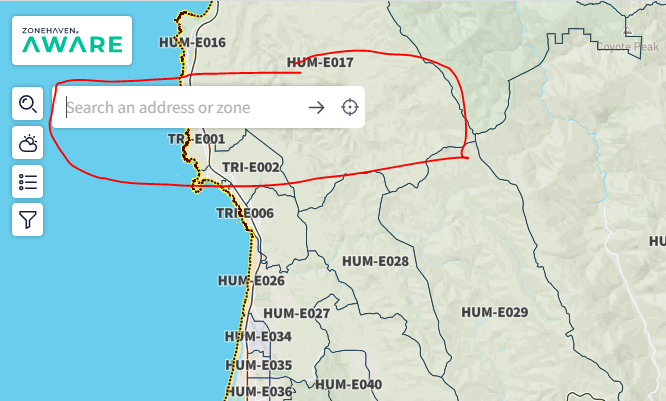Evacuation Orders and Warnings Expand as of 7:36 p.m. for Residents of the Willow Creek Area

As of 7:36 p.m., this is the latest evacuation information map. The red is the zone under an evacuation order. The yellow zone is under an evacuation warning. The blue is an advisory.
Humboldt County Office of Emergency Services tweeted at 7:36 p.m.:
Due to #SixRiversLightningComplex Fire, an immediate #EVACUATION ORDER is being issued for zones HUM-E077-C, HUM-E058 and HUM-E061, south and east of Willow Creek. See map: tinyurl.com/2p87nzmj (1/2)
EVACUATION WARNING is being issued for zones HUM-E063, HUM-E064, and HUM-E077-B, south/southeast of Willow Creek. Prepare for potential evacuations, including personal supplies and overnight accommodations. Be ready to go at a moment’s notice. (2/2)
Always check ZoneHaven for the latest information. If you are unsure what zone you are in, on the top left hand corner is a place to put your address.

The ZoneHaven address bar is circled in red.
Once an address is entered, click the arrow.

Once the arrow is clicked, a red marker shows your zone.
Further Information:
Red zones are Evacuation Order zones. EVACUATION ORDER: Immediate threat to life. This is a lawful order to leave now. The area is lawfully closed to public access.
Yellow zones are Evacuation Warning zones. EVACUATION WARNING: Potential threat to life and/or property. Those who require additional time to evacuate, and those with pets and livestock should leave now.
Blue zones are advisory zones. Be aware that wildfires are occurring in the area.Evacuation-Checklist-2020-one-page
More information from here to prepare ahead of time for an evacuation:
- PRE-EVACUATION PREPARATION STEPS
When an evacuation is anticipated, follow these checklists (if time allows) to give your home the best chance of surviving a wildfire.
Home Evacuation Checklist – How to Prepare for Evacuation:
Inside the House
- Have your Emergency Supply Kit/Evacuation Bag ready to go
- Ensure a Wildfire Action Plan is prepared ahead of time
- Make sure you know your community’s emergency response plan and have a plan on where to go when it is time to evacuate, and best routes for leaving your location.
- Shut all windows and doors, leaving them unlocked.
- Remove flammable window shades, curtains and close metal shutters.
- Remove lightweight curtains.
- Move flammable furniture to the center of the room, away from windows and doors.
- Shut off gas at the meter; turn off pilot lights.
- Leave your lights on so firefighters can see your house under smoky conditions.
- Shut off the air conditioning.
Outside
- Gather up flammable items from the exterior of the house and bring them inside (patio furniture, children’s toys, door mats, trash cans, etc.) or place them in your pool.
- Turn off propane tanks.
- Move propane BBQ appliances away from structures.
- Connect garden hoses to outside water valves or spigots for use by firefighters. Fill water buckets and place them around the house.
- Don’t leave sprinklers on or water running, they can affect critical water pressure.
- Leave exterior lights on so your home is visible to firefighters in the smoke or darkness of night.
- Put your Emergency Supply Kit in your vehicle.
- Back your car into the driveway with vehicle loaded and all doors and windows closed. Carry your car keys with you.
- Have a ladder available and place it at the corner of the house for firefighters to quickly access your roof.
- Seal attic and ground vents with pre-cut plywood or commercial seals.
- Patrol your property and monitor the fire situation. Don’t wait for an evacuation order if you feel threatened.
- Check on neighbors and make sure they are preparing to leave.
Animals
- Locate your pets and keep them nearby.
- Prepare farm animals for transport and think about moving them to a safe location early.
- Pets: https://www.livingwithfire.com/get-prepared/
Step 5: Prepare for Pets
Prepare to address the needs of your pets if you have to evacuate.
- Make sure dogs and cats wear properly fitted collars with identification, vaccination, microchip and license tags.
- Your pet evacuation plan should include routes, transportation needs and host sites. Share this plan with trusted neighbors in your absence.
- Exchange veterinary information with neighbors and file a permission slip with the veterinarian authorizing emergency care for your animals if you cannot be located.
- Make sure all vehicles, trailers and pet carriers needed for evacuation are serviced and ready to be used.
- Assemble a pet to-go bag with a supply of food, non-spill food and water bowls, cat litter and box and a restraint (chain, leash or harness). Additional items to include are newspaper and paper towels, plastic bags, permanent marker, bleach/disinfectant solution and water buckets.

Join the discussion! For rules visit: https://kymkemp.com/commenting-rules
Comments system how-to: https://wpdiscuz.com/community/postid/10599/
How big is this fire. Unknown size?
*fires x 6
500 acres as of last night, but this is going to be hairy. They are all around WC.
Can we get a more detailed base map? Perhaps a USGS topo map.